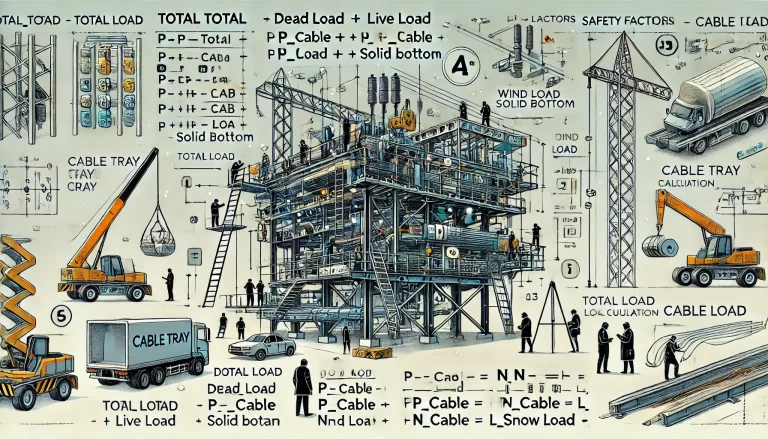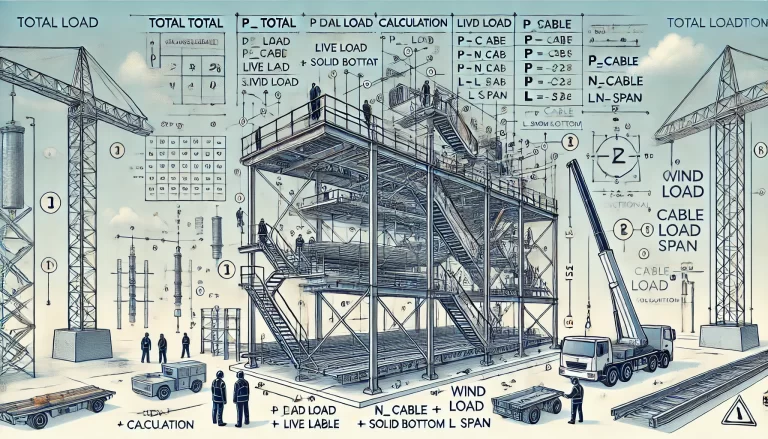Cable tray systems are essential for supporting and routing instrument cables in industrial and commercial installations. Proper load calculation ensures the safety, efficiency, and longevity of the cable tray system. This guide provides a comprehensive approach to calculating cable tray loads, considering various factors such as cable weight, tray weight, environmental influences, and safety factors.
1. Classification of Loads
Cable tray loads can be classified into the following categories:
Dead Load (G): This includes the weight of cables, the weight of the tray itself, and any permanent fixtures.
Live Load (Q): Temporary loads such as maintenance personnel, tools, and other equipment placed on the tray.
Environmental Loads:
Wind Load (W): Forces exerted by wind on outdoor installations.
Snow Load (S): Accumulated snow weight in regions experiencing snowfall.
2. Basic Load Calculation Formula
The total load on the cable tray system can be calculated using the following formula:
Where:
: Total weight of cables
: Weight of the cable tray
: Additional loads such as wind, snow, and maintenance loads

3. Step-by-Step Calculation Procedure
Step 1: Determine Cable Type and Quantity
Identify the types and quantities of cables to be installed based on design drawings. Common types include:
Signal cables
Control cables
Power cables
Step 2: Calculate Cable Load
The cable load can be calculated using:
Where:
: Cable weight per meter (kg/m)
: Number of cables
: Support span length (m)
Example Calculation: If each cable weighs 2 kg/m, there are 20 cables, and the span is 2 meters:
Step 3: Calculate Cable Tray Weight
Cable tray manufacturers provide weight specifications based on tray type and material. The tray weight can be calculated using:
Where:
: Cable tray weight per meter (kg/m)
: Support span length (m)
Example Calculation: If the tray weighs 10 kg/m over a 2-meter span:
Step 4: Consider Additional Loads
If the installation is outdoors, additional loads such as wind and snow should be considered:
Wind Load: Calculated using the formula:
Where is the wind pressure coefficient and is the exposed area.
Snow Load: Determined based on regional snow accumulation guidelines.
Step 5: Applying a Safety Factor
To ensure reliability, an appropriate safety factor (typically 1.5 to 2.0) should be applied to the total load.
Example Calculation with Safety Factor of 1.5:
4. Recommended Support Spacing
The spacing of cable tray supports depends on the calculated load and tray type. Typical recommendations include:
| Tray Type | Maximum Span (m) |
|---|---|
| Ladder Tray | 1.5 – 3.0 |
| Trough Tray | 1.5 – 2.5 |
| Solid Bottom | 1.5 – 2.0 |

5. Cable Tray Load Capacity Guidelines
Different cable trays have different load capacities based on their design and material. Approximate load capacities per meter are:
| Cable Tray Type | Load Capacity (kg/m) |
| Ladder Tray | 100-200 |
| Perforated Tray | 150-250 |
| Solid Bottom | 200-400 |
6. Additional Considerations
Thermal Expansion: Allow for expansion and contraction in long cable tray runs.
Corrosion Protection: Consider environmental exposure and use corrosion-resistant materials.
Fire Safety: Ensure compliance with fire rating requirements and implement fire stops as needed.
Load Testing: Perform on-site load testing when necessary.
7. Conclusion
Accurate cable tray load calculation is critical for ensuring the safety and efficiency of the installation. By following the outlined steps—considering cable weight, tray weight, environmental factors, and applying safety factors—you can design a reliable cable tray system that meets industry standards and operational requirements.
